Episode 216
What you’ll learn in this episode:
- Why artist jewelry is more than just miniature versions of larger work
- The history of artist jewelry, and how Esther is helping its story continue
- How Esther helps artists with their first forays into jewelry, and why making jewelry can be a fruitful challenge for fine artists
- Why an artist’s first idea for a piece of jewelry is often not their best
- Why artist jewelry collectors must be brave
About Esther de Beaucé
Esther de Beaucé is the founder and owner of Galerie MiniMasterpiece in Paris, France. MiniMasterpiece is a gallery entirely dedicated to contemporary artists, designers and architects’ jewelry. The gallery is an invitation given to those who usually never design jewelry because their work evolves on a more monumental scale (i.e. sculptures). Esther’s passion is to convince those artists to change the scale of their work and accompany them in that new field of wearable art. She has collaborated with acclaimed contemporary artists such as Phillip King, Bernar Venet, Andres Serrano, Lee Ufan, Jean-Luc Moulène, and Pablo Reinoso.
A graduate of Brown University, Esther previously co-owned the gallery Schirman & de Beaucé in Paris, dedicated to young artists of contemporary art.
Photos available on TheJewelryJourney.com
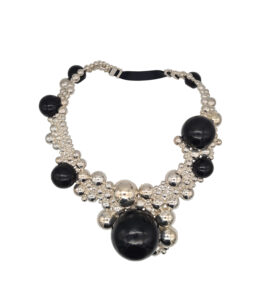
1 – “Extravaganza” necklace by franco-portuguese artist JOANA VASCONCELOS
in sterling silver and lacquer. It is a unique piece that was made in 2022 for the gallery’s 10th birthday.
Vasconcelos is a fantastic contemporary artist and Extravaganza is her first art jewel. The making of this piece was a great challenge –
over 250 hollowed silver spheres to combine !
© MiniMasterpiece
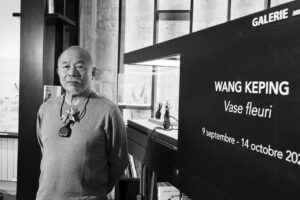
2 – Chinese artist WANG KEPING at the gallery during his jewelry solo show in 2022.
© Michel Lunardelli
I love my collaboration with Keping – he is a great artist and a beautiful human being. We plan on working again together in 2024.
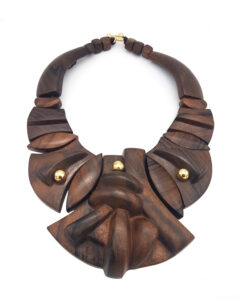
3 – “Hyperion” necklace by greek artist SOPHIA VARI
in ziricote wood and 18k yellow gold, 2022, edition of 3 + 2AP
Vari, who passed away earlier in May 2023, was one of the very first artist I worked with.
She was amazingly talented. Her jewels are both powerful and very sophisticated. She is very missed by all jewelry lovers.
© MiniMasterpiece
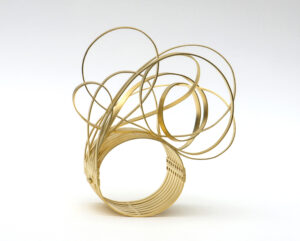
4 – “Loopingcuff” by argentinian artist PABLO REINOSO
in sterling silver plated 18k yellow gold. One of the most beautiful cuff I edited (2018 – edition of 8).
As beautiful on the body as left a small sculpture.
© MiniMasterpiece
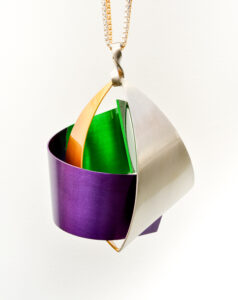
5 – “Liaisons amoureuses” pendant by english artist PHILLIP KING
in 18k yellow gold, sterling silver and lacquer, made in 2017 in an edition of 10.
In february 2024, I will show his most recent jewels – 3 never seen before sculptures-to-wear
that he sent me the day before he passed away in 2021.
© Yann Delacour
Additional Resources:
Transcript:
For gallerist Esther de Beaucé, artist jewelry isn’t completely art or completely contemporary jewelry. It’s in a niche all its own—and that’s what makes it fascinating. As founder and owner of Galerie MiniMasterpiece in Paris, she helps fine artists translate their art into jewelry, creating something entirely new rather than a smaller version of their typical work. She joined the Jewelry Journey Podcast to talk about how she challenges artists to think about their work differently; how interest in artist jewelry has evolved over the years; and why artist jewelry collectors are so open minded. Read the episode transcript here.
Sharon: Welcome to the Jewelry Journey, exploring the hidden world of art around you. Because every piece of art has a story, and jewelry is no exception.
Hello, everyone. Welcome to the Jewelry Journey Podcast. This is the first part of a two-part episode. Please make sure you subscribe so you can hear part two as soon as it’s released later this week.
I don’t remember how I found out about Esther de Beaucé’s gallery in Paris. It is tucked back in the corner with other galleries. I don’t know, unless you are looking for it, if you would find it easily. It was an intentional destination for me both times I’ve been there. It is very hard to find. I was determined that I was going to find it, and after a little bit of time I did find it. It is a very cozy and comfortable gallery, and Esther herself is easy to talk to.
The gallery specializes in jewelry designed by artists. Some are French, some are Italian, and I’m sure there are others. The prices are very reasonable compared with other shops with jewelry by artists where you find a pretentious atmosphere. Esther speaks English flawlessly, having attended Brown College, and she has been on the podcast before, many moons ago. I’ll let her tell you the rest of the story. Esther, welcome to the program.
Esther: Hello, Sharon. Thank you for having me today.
Sharon: I’m so glad to have you. So, why did you choose to sell jewelry by artists?
Esther: I wanted to work with artists, contemporary artists, because before MiniMasterpiece, I had a first gallery also in Paris, working with young artists on paintings and sculptures and drawings. That gallery had to end, and my obsession was continuing working with artists because I really enjoyed that, that work, but I had to find another way. There are many art galleries in Paris, and I wanted to find a more special way to work with them. I knew of artist jewelry, and there aren’t many places in the world and in Paris, either, for artist jewelry. So, this is how I started. Sorry, I think I said enough.
Sharon: No, please, go ahead.
Esther: So, at first, it was more for the pleasure of working with artists than that of making jewelry. After 12 years, I became very fond of jewelry, of course. I wouldn’t say exactly the same thing, but back in time, 12 years ago, it was really my love for artists.
Sharon: It was your love for artists. How was it changing from the drawings and the paintings and all of that to jewelry? Was it natural? Was it different?
Esther: Yeah, it’s a challenge for them, of course, when I invite them to think of their work at a different scale. They have to think of the body, which most of the time they never do because when you make a sculpture or a painting or a photograph, obviously it’s not to be worn.
But this time it was a big challenge for them and also for me, because 12 years ago I knew little about jewelry making itself. We both had to learn. It was a challenge for them, and it was also a challenge for me. But I knew that it was possible because it’s a story that goes back in time for about a century now, with Picasso and Calder and Giacometti, all those great visual artists who made a few wearable art pieces on the side of their main activity.
Sharon: Was it scary for you to start asking artists if they would do their jewelry, if they would make jewelry?
Esther: I started asking those artists I knew personally because they were family friends, or I had worked with them in the past with that former gallery I had. So, I didn’t take many risks the first year. Then I got more brave and I started to ask other artists. I only ask those artists where I like the work. I am a big fan of their monumental work. They are mostly sculptors. It’s because I like their sculpture, but I think of inviting them to make a sculpture to wear.
Sharon: Do they look at you funny, like, “What are you talking about?” Or, “I don’t understand what you mean”?
Esther: Most of them understand the idea. I’ve had several artists say no, but not that many. Sometimes they even thought about making a jewelry piece but never had the occasion to do so because they need to be surrounded by the good people. Very often they need to be accompanied by a goldsmith because they haven’t mastered the work of gold or silver, so they need help on that matter. But once you invite them and tell them about that great story and how many artists have worked on that subject in the past, and that you can take them to the right goldsmiths that can help them understand their project, then it’s much easier for them to accept.
Sharon: And have they ever rejected you and just said, “Forget it. That’s weird”?
Esther: Yeah, of course they have. Sometimes it’s because they don’t get a good idea. Finding the right idea is not that easy. Sometimes they don’t have time. Sometimes it’s not a good time for them to spend some energy on that project. And of course, I understand that perfectly.
In very, very, very few cases, sometimes they don’t take jewelry very seriously. They have that image of jewelry being something not serious. But there are many artists I can invite, and those who don’t want to play with me, it’s no big deal.
Sharon: Do you leave it to them to decide if it’s a bracelet or a ring or a necklace or what they’re going to make?
Esther: Yes, of course. I open possibilities for them as wide as they want at the beginning. Then once they have ideas, we talk. Once it gets more precise, if they are going to make only one piece of jewelry, sometimes I advise them to think of a ring or a necklace because they are the most iconic type of jewels. If they have several ideas, then why not add a bracelet or earrings? But if they have to make only one, I usually recommend them to make a necklace. Also, because a necklace leaves more volume and space for them to express themselves. Sometimes it’s very difficult for them to condense their work into a very tiny piece. A necklace is bigger.
Sharon: What do you say to them if they say, “Esther, I’m a sculptor. I don’t know how to make this small”? What do you say?
Esther: I say that what I’m interested in is the DNA of their work. An idea has no size. Basically, it would be the same as making a very large sculpture. But when they are invited by a museum or a gallery, they are given a space to make. Sometimes they make a sculpture especially for that space, a museum or a gallery. I just tell them, “Well, this time you have to make a piece of a sculpture for the body.” It is just another way of thinking, and artists like to be challenged. It’s a very big challenge for them, but they are very often excited by that challenge.
Sharon: Are they doing other things? Are they making the jewelry for your gallery, and they’re working on a sculpture or painting at the same time? It might be a different subject, but I’m wondering.
Esther: Yes. I think they’re on different topics at the same time. Also, when they have to think of making a wearable sculpture, sometimes it helps them to think of a new idea for a monumental work. This is something they have said to me on various occasions, that going from big to small and then back to big is also interesting for them. Sometimes it has an impact on how they think big afterwards.
Sharon: You’re located in the antique district in Paris, right?
Esther: Yes. Not only antiques. It’s called the Carré Rive Gauche. It’s a very special geography because it’s like a square with about six streets. It’s very unique in the world because in that square you have about 120 galleries and antique shops of different specialties. You have contemporary art, you have antiques, you have Chinese art, African art, glass works, silver works. It’s very unique to have such a strong—how would you say that—density of art shops.
It’s not like—you know the Marais? The Marais is another district that is very focused on contemporary design and contemporary art. Carré Rive Gauche and Saint-Germain-des-Prés reunites a wider range of art galleries, and I really like that mix. I feel very comfortable in that. It’s a very enriching environment.
Sharon: From the beginning did you know that was where you wanted to be?
Esther: Yes, because it’s the neighborhood where I grew up, and I’d never had a professional project in that area. And it’s a lovely neighborhood. I love it. A lot of tourists as well still go to Saint-Germain-des-Prés. There aren’t many places for rent, and sometimes they are very expensive. This is also why I’m in a courtyard, where you have to find your way through. But once you’ve been here for the first time, then it’s easy to come back. There are many courtyards like this in Paris, and it’s also the Parisian charm of finding the remote places. I like that idea.
Sharon: It is very charming, and the Parisian charm is both in your gallery and the courtyard around it. Do you get people stumbling in? Tourists or French people who are just wandering around who find the gallery?
Esther: Yes, of course. I have a sign on the street also. There are actually three different galleries in the courtyard, so we have a sign on the street with the name of the galleries. The large doors are open all day long, and there are many plants. I have random people coming very often, for sure.
Sharon: When did you become attracted to jewelry?
Esther: As a kid, because my mother is a great collector of artist jewelry, and I learned a lot from her. Since I was a kid, I’ve seen her wearing those weird pieces of jewelry that were artist jewelry only, no stones, no diamonds, only artist jewelry. That was very different from my friends’ mothers, obviously.
So, it was very natural to me, but I never imagined myself being a professional in that area because it was hers. But I found a way of making it mine because she’s a collector and I’m an editor. I make new projects. Sometimes when she likes them, she gets them for her collection, but not always. So, I found a way of having my own role in artist jewelry different from hers. But I was really fed by her passion as a kid.
Sharon: Did you think you were going to draw or paint professionally? What did you imagine yourself doing?
Esther: No, I have no artistic talent myself. I really love working with artists and I’m the person next to them, but I have no desire to create myself. Even after 12 years of MiniMasterpiece, I have no desire to make jewelry myself. Artists come up with such great ideas all the time that I really don’t have to think about this myself. But they need me for other things, so I’m happy to take care of all the rest.
Sharon: When you say they need you for other things, I was thinking you are creative. You couldn’t guide them, right?
Esther: Yes, but I don’t have the idea. I know how to make their ideas grow and make it possible, but it’s really their work. The starting point is their work and their idea. I make it possible after that.
Sharon: Who decides if it is going to be a limited edition and there are only a few? Who decides how many there are going to be?
Esther: It’s a tricky question. I discuss it with the artist, and we take into consideration the costs of their making, obviously. Sometimes it’s a series of unique pieces. I’ve done that on several occasions. So, it’s not really an edition; it’s a series of 10 unique pieces, for example. Most of the time we make 10 or 12 different numbers of the same piece to stick to what is commonly made in sculptures. So, most of the jewels from the gallery run in an edition of 10 or 12 pieces.
Sharon: You started to say that 30, though, is the limit to call it a limited edition, right?
Esther: Yes, 30 is the maximum for us to call it an original piece of work. Most of the time after 30, it’s not an original piece of work. I don’t know how you would call it, but it would be just a regular edition. It’s very rare that I go above 30. It has happened in the past, because sometimes museum shops call me for a special edition if they have a show of that artist running and they want to have a piece of jewelry in their shops. This is a very special project for me, and in that case, we make a larger edition. But this is very site specific.
Sharon: How do you find the artists? Do you go to parties to look for them? Do you go to galleries? How do you find them?
Esther: I go to art shows and exhibitions for the most time. When I find an artist whose work I like very much, then I try to find a way to contact him or her. But the first thing for me is to grasp and understand and like their work. After that, I try to find a possible way to get in contact with them.
Sharon: Do they ever approach you first?
Esther: Yes, it has happened, of course. There’s a great Chinese sculptor in France called Wang Keping, with whom I’ve had the chance to work for the past four years. I met him at an art fair, and it was a great encounter because he’s a fabulous man and a fantastic artist. It was a great, almost random encounter.
Sharon: But he came to you. You looked at his work and liked his work, and he came to you?
Esther: Yes. I was about to go to him, and then we met and he also wanted to discuss with me. So it was a random encounter, and it ended very well.
Sharon: What is the overall state of artist jewelry—well, there are two questions—and art jewelry in France?
Esther: What’s the difference for you between artist jewelry and art jewelry?
Sharon: That’s an interesting question. I guess artist jewelry is by somebody who, it isn’t their primary medium. They do painting and sculpture, and once in a while they do a pin or a ring or whatever. And the other is jewelers who do different jewelry.
Esther: Yeah. It’s their specialty. Making jewelry is their specialty.
Sharon: Yes.
Esther: So, you would call that art jewelry?
Sharon: Yes.
Esther: Okay.
Sharon: I would call both art jewelry. But the artist jewelry—
Esther: Yes. Well, I know of art jewelry, but not as well as artist jewelry, obviously, because only artist jewelry is my specialty. So, I wouldn’t be able to speak of art jewelry as well. For artist jewelry, I think it’s getting better because there are more editors working on the subject and inviting new artists, so it’s more dynamic. It seems that in the 60s and in the 70s, the market for artist jewelry in France and in the world was more dynamic than in the 80s, in the 90s, in the early 2000s. For the past 15 years, maybe, it’s getting more dynamic because new editors have started working on the subject.
Museum shows have also taken place thanks to great collectors that are organizing shows on their collections. Books also have come out. So, slowly, I think it’s getting more dynamic. But still, it’s a story that needs to be explained more, and a lot of people don’t know about it yet. So, it’s also our mission to explain that story and to tell and to show.
I think it’s also the case for art jewelry. There aren’t that many galleries and places in Paris that sell art jewels. I’m looking forward to the years to come because I believe it’s going to get more and more dynamic.
Sharon: Are the people who come, who assemble on your gallery, are they coming because they think, “Oh, it’s jewelry. I want to look at diamonds and pearls,” and you have to explain what it is?
Esther: Yes, all the time. All the time. Sometimes I talk for five, 10 minutes explaining the concept of the gallery, and they look at me and say, “Oh, so you are making the jewelry.” And I’m like, no, no, no, no, no, no. I’m not making the jewelry. I invite those who never make jewelry, and I ask them for a special project for the gallery.
So, it takes a lot of energy explaining. Of course, some people know of that story, so it makes it easier for me. But I also like the challenge of getting that story more well-known and convincing women and men that this is also part of the jewelry world. It’s not because the piece of jewelry doesn’t have stones or diamonds that it’s not worth it. Then we talk about value and what makes a jewel precious or not precious. So, it leads to interesting conversation. But it takes a lot of my time explaining that.
Sharon: You said something I have to think about because I’m not sure I’ve thought about it, and that is that artist jewelry is part of the jewelry world.
Esther: Of course.
Sharon: Yeah. If you had asked me 10 minutes ago, I would have said yes, but I really would have had to think about it.
Esther: It’s contemporary jewelry, and contemporary jewelry has different compartments. I don’t know how you would say that, but a small part of contemporary jewelry is that of artist jewelry, because it’s being made today. So, for me, it’s definitely part of it.
Sharon: Do you ever have shows, meaning you take your gallery, the artist jewelry, and you cart it somewhere and show it? Do you put it out for people to look at?
Esther: You mean outside the gallery?
Sharon: Yeah.
Esther: Yes. Several times a year I try to be in fairs. I’ve never shown in a jewelry fair because I’ve always want to place the jewelry in a design or contemporary art background. So, I always try to show in design or art fairs, which is not always easy because there aren’t that many art fairs, for example, that leave space for art jewelry. So, it’s a tricky thing for me, to find a good place outside of the gallery to show that kind of jewelry.
Although artist jewelry is part of art jewelry and contemporary jewelry at large, it’s a bit different. I’m trying to connect it. I want the connection with the art and design world to be very strong, more than that of jewelry at large. I want to place it into an art environment as much as possible, so also for fairs.
Sharon: What if you don’t like the first drawing or the first couple of drawings of something that an artist shows you for a ring, let’s say, or a bracelet? What do you do?
Esther: If I don’t like it, it’s very often because it doesn’t look like them. It’s not connected well enough to their work, to what they are. Sometimes the first idea they have is an idea of a jewel, but it’s more than just making a jewel. It’s making their work into a jewel, you know? So, sometimes the first idea is not the right one, but it’s not because it wouldn’t make a nice jewel. It would. But you wouldn’t recognize their work in that small piece. And it’s very important for me that the link is very strong.
But for me, a good artist jewel is not a reduction of a bigger project. This is not very interesting, to make very small exactly what you make in large. It has to be a new project, yet you have to recognize the artist’s work. This is the biggest challenge in the making of an artist jewel.
Sharon: I’m thinking, and I can’t remember his name, that the Spanish sculptor who makes puzzles. He makes them large and he makes small, little pendants and things like that. He’s Spanish.
Esther: Maybe he’s Franco-Argentinian, Pablo Reinoso?
Sharon: No, that’s not his name. But has Reinoso been part of your sculptures, your gallery?
Esther: Yes, among many other ones. But, you know, I walked the path of artist jewelry for 12 years, and I’ve also evolved on that path. What I think today might be different than what I thought in the past, and it’s the same for artists. I know their first idea is going to be nice, but maybe it’s not going to be as interesting as the second idea or as the third idea. But I also have to respect their rhythm, that it’s going to take a bit of time and that they have to grasp the idea of jewelry. Because this is so new to them, you also have to be patient.
Sharon: Do you make the first or second drawing they have, even if you don’t like it, and then you wait for them?
Esther: No, I ask them to work hard for the first project as well, but I notice sometimes that the first project is very nice and interesting, yet the second one or the third one or the fourth one is even more interesting because it—how would I say that—it is more demanding. It is maybe less commercial. I have the feeling that the artist and myself have walked that path a bit more as it gets more interesting.
It’s also more demanding for the collector. It’s really from the artist to the collector. I’m sure you’re not the same collector today as you were 30 years ago. And maybe what you choose to wear today or what you assume to wear today is different from many moons ago. I think we all go through that path, and it’s very interesting. It doesn’t mean that what you make at first is not interesting, but you have to go through all these steps.
Sharon: We will have photos posted on the website. Please head to TheJewelryJourney.com to check them out.
Thank you again for listening. Please leave us a rating and review so we can help others start their own jewelry journey.

